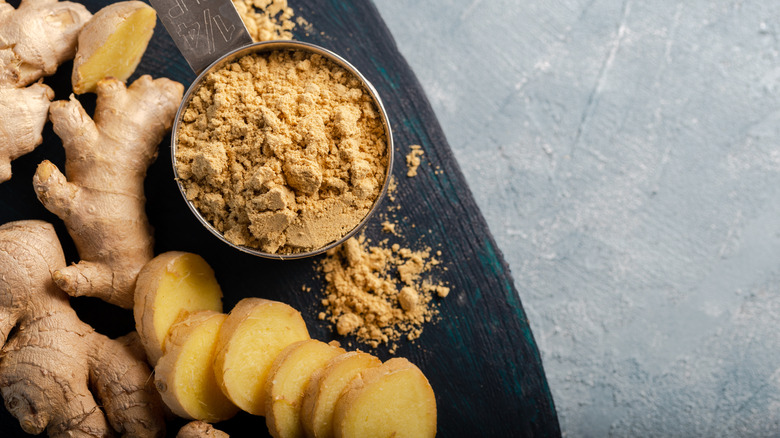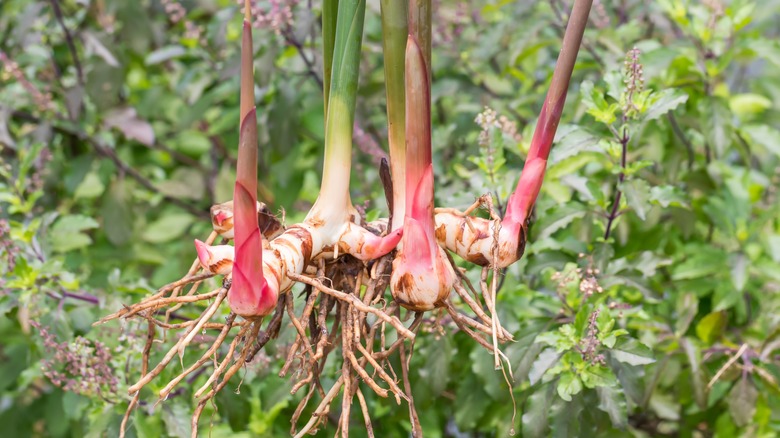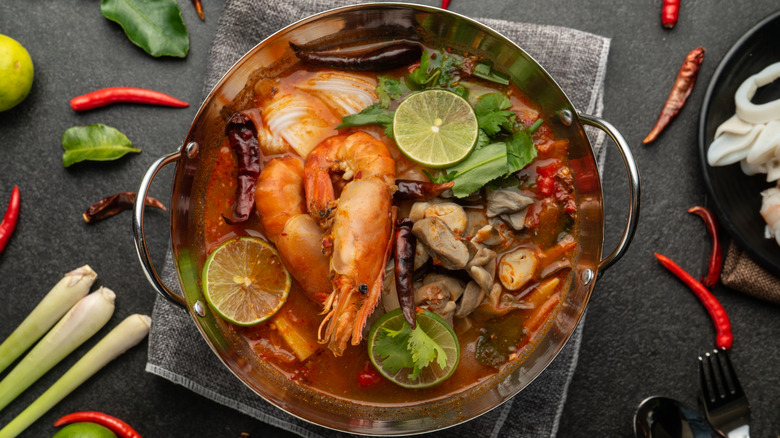Do Galangal And Ginger Taste Different?
Tubers may be a close-knit clan, but they don't all taste the same. In fact, even very similar tuber siblings hold distinct personalities and land on human tastebuds in different ways. That's especially true with galangal and ginger. Though Southeast Asian recipes sometimes suggest ginger as a substitute for the less commonly available galangal, that would be a mistake, according to experts such as Pailin Chongchitnant, author of the "Hot Thai Kitchen" cookbook. The Victoria Times Colonist quotes the author as saying the two tubers are "as different as yin and yang," cautioning chefs against using them interchangeably.
Apart from diverging flavor characteristics, the two share several things in common, including lineage and health benefits, notes Healthline. Both galangal and ginger live within the Zingiberaceae family of plants, and both host edible roots known as tubers, rhizomes, herbs, or spices, depending on application and perspective, explains Smart Garden Guide.
According to Healthline, the two prominent Thai-food ingredients also have long-time ties to traditional Chinese and Ayurvedic medicine. Due to family origins, galangal may join ginger in reducing risks for heart disease, type 2 diabetes, memory loss, and age-related brain-function issues.
It's easy to see why some recipes advocate interchangeability between cooking with ginger and galangal. Still, when it comes to flavoring your Thai dishes, you could end up with an unexpected taste and texture on your tongue.
Ginger is peppery and sweet, while galangal is earthier and sharp
You may struggle visually when differentiating between galangal and ginger. Though not exactly tuber twins, the two culinary spices do look alike. But galangal has a lighter complexion and more rugged flesh than its ginger sibling, according to MasterClass. Ginger lends itself well as a powder, while the tougher galangal holds up to robust slicing and dicing.
The flavor profiles are where the similarities split abruptly. Though galangal is sometimes called Thai or Siamese ginger, that can be misleading when it comes to taste. Galangal digs deeper with an earthier, more pronounced flavor than ginger, explains Spice Tutor. You'll taste citrus notes with hints of pine, leaning more toward sharp than sweet. Spiceography further distinguishes between two galangal types, commonly referred to as greater and lesser galangal. The "greater" version introduces cinnamon notes and an overall floral flavor, while the "lesser" adds a slightly medicinal touch.
Ginger instead pops with punches of spice and pepper, notes MasterClass, leaving a warm trail from tongue to tummy. When used in fresh form, it adds depth to otherwise bland sauces and soups or gives a lightening lift to complex curries.
Both spices are prominent in Asian cuisine
The two tuber-based food spices feature in cuisine from countries spanning the Asian continent. That's unsurprising considering the similar ancient history of both ginger and galangal. According to a report published by the National Library of Medicine, ginger appeared as an ingestible flavoring and medicinal tonic root in India and China more than 5,000 years ago. It also became entwined with the import and export markets between India and the Roman Empire, eventually leading to its prominence in Arab and European trading. In other words, the magic of ginger is nothing new.
Galangal got around as well. Spiceography notes that it originated in Indonesia, featured in Javan, Chinese, and Roman societies, and entered similar Arab and European spice routes. In fact, the Latin name of galangal, Alpinia, reportedly came from Italian botanist Prospero Alpini who created recipes with the spice.
Given all that roaming, it's no wonder each spice holds similar recipe applications in Asian cooking but with regional nuances. Curries and stir-fries make liberal use of each spice, but Chinese and Indian dishes, in particular, feature ginger. China Highlights claims you'll find it in most Chinese recipes, including sauces and soups, especially when accompanied by garlic.
Galangal is particularly prominent in Southeast Asian cuisine from Malaysia, Indonesia, Laos, and, especially, Thailand, per MasterClass. You're almost certain to use it as an essential ingredient when you cook Thai food at home, like tom yum or tom kha gai soup or one of the various curry pastes, according to Thai Table.


